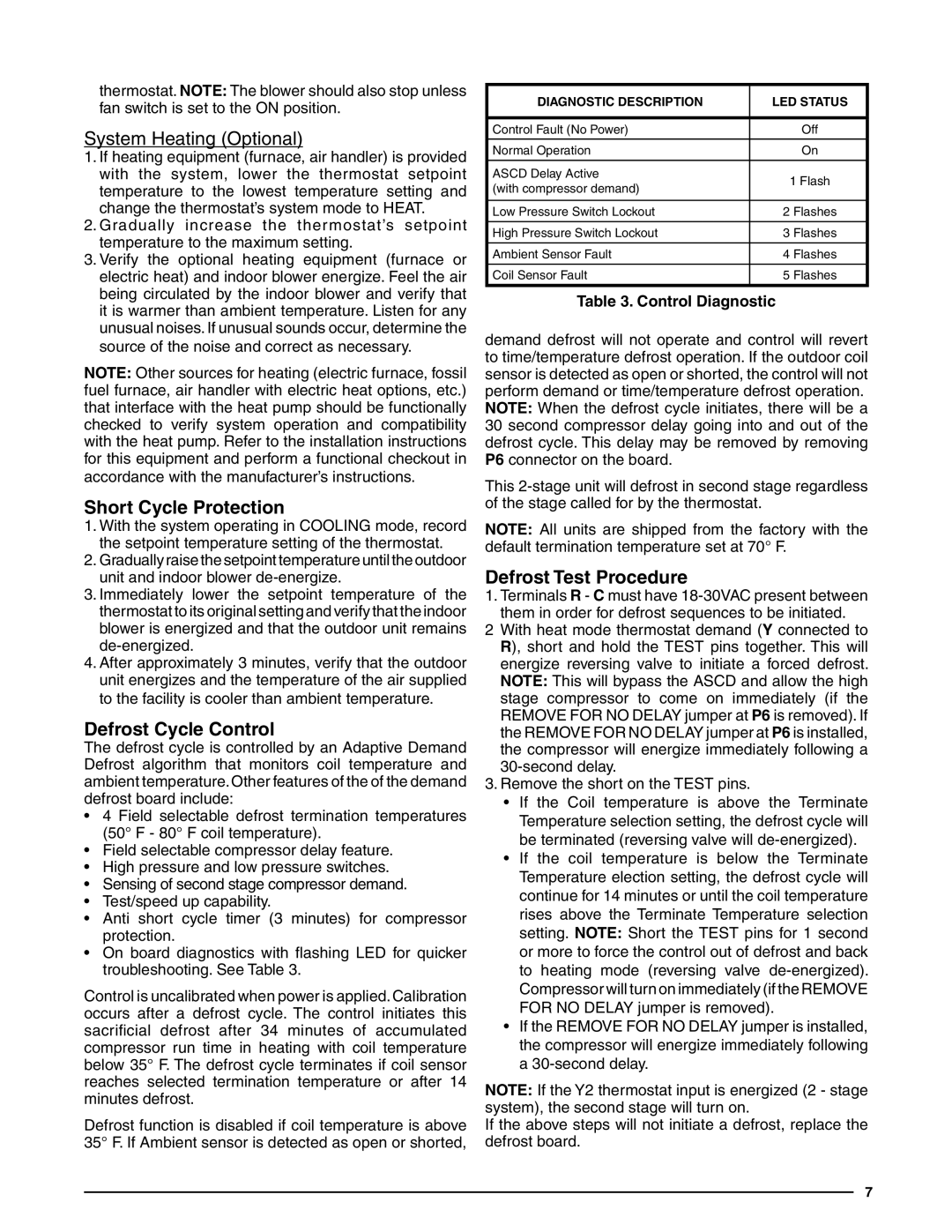thermostat. NOTE: The blower should also stop unless fan switch is set to the ON position.
System Heating (Optional)
1.If heating equipment (furnace, air handler) is provided with the system, lower the thermostat setpoint temperature to the lowest temperature setting and change the thermostat’s system mode to HEAT.
2.Gradually increase the thermostat’s setpoint temperature to the maximum setting.
3.Verify the optional heating equipment (furnace or electric heat) and indoor blower energize. Feel the air being circulated by the indoor blower and verify that it is warmer than ambient temperature. Listen for any unusual noises. If unusual sounds occur, determine the source of the noise and correct as necessary.
NOTE: Other sources for heating (electric furnace, fossil fuel furnace, air handler with electric heat options, etc.) that interface with the heat pump should be functionally checked to verify system operation and compatibility with the heat pump. Refer to the installation instructions for this equipment and perform a functional checkout in accordance with the manufacturer’s instructions.
Short Cycle Protection
1.With the system operating in COOLING mode, record the setpoint temperature setting of the thermostat.
2.Gradually raise the setpoint temperature until the outdoor unit and indoor blower de-energize.
3.Immediately lower the setpoint temperature of the thermostat to its original setting and verify that the indoor blower is energized and that the outdoor unit remains de-energized.
4.After approximately 3 minutes, verify that the outdoor unit energizes and the temperature of the air supplied to the facility is cooler than ambient temperature.
Defrost Cycle Control
The defrost cycle is controlled by an Adaptive Demand Defrost algorithm that monitors coil temperature and ambient temperature.Other features of the of the demand defrost board include:
•4 Field selectable defrost termination temperatures
(50° F - 80° F coil temperature).
•Field selectable compressor delay feature.
•High pressure and low pressure switches.
•Sensing of second stage compressor demand.
•Test/speed up capability.
•Anti short cycle timer (3 minutes) for compressor protection.
•On board diagnostics with flashing LED for quicker troubleshooting. See Table 3.
Control is uncalibrated when power is applied. Calibration occurs after a defrost cycle. The control initiates this sacrificial defrost after 34 minutes of accumulated compressor run time in heating with coil temperature below 35° F. The defrost cycle terminates if coil sensor reaches selected termination temperature or after 14 minutes defrost.
Defrost function is disabled if coil temperature is above 35° F. If Ambient sensor is detected as open or shorted,
| DIAGNOSTIC DESCRIPTION | LED STATUS |
| | |
| Control Fault (No Power) | Off |
| | |
| Normal Operation | On |
| | |
| ASCD Delay Active | 1 Flash |
| (with compressor demand) |
| |
| | |
| Low Pressure Switch Lockout | 2 Flashes |
| | |
| High Pressure Switch Lockout | 3 Flashes |
| | |
| Ambient Sensor Fault | 4 Flashes |
| | |
| Coil Sensor Fault | 5 Flashes |
Table 3. Control Diagnostic
demand defrost will not operate and control will revert to time/temperature defrost operation. If the outdoor coil sensor is detected as open or shorted, the control will not perform demand or time/temperature defrost operation. NOTE: When the defrost cycle initiates, there will be a 30 second compressor delay going into and out of the defrost cycle. This delay may be removed by removing P6 connector on the board.
This 2-stage unit will defrost in second stage regardless of the stage called for by the thermostat.
NOTE: All units are shipped from the factory with the default termination temperature set at 70° F.
Defrost Test Procedure
1.Terminals R - C must have 18-30VAC present between them in order for defrost sequences to be initiated.
2 With heat mode thermostat demand (Y connected to R), short and hold the TEST pins together. This will energize reversing valve to initiate a forced defrost. NOTE: This will bypass the ASCD and allow the high stage compressor to come on immediately (if the REMOVE FOR NO DELAY jumper at P6 is removed). If the REMOVE FOR NO DELAY jumper at P6 is installed, the compressor will energize immediately following a 30-second delay.
3.Remove the short on the TEST pins.
•If the Coil temperature is above the Terminate
Temperature selection setting, the defrost cycle will be terminated (reversing valve will de-energized).
•If the coil temperature is below the Terminate
Temperature election setting, the defrost cycle will continue for 14 minutes or until the coil temperature rises above the Terminate Temperature selection setting. NOTE: Short the TEST pins for 1 second or more to force the control out of defrost and back to heating mode (reversing valve de-energized).
Compressor will turn on immediately (if the REMOVE FOR NO DELAY jumper is removed).
•If the REMOVE FOR NO DELAY jumper is installed, the compressor will energize immediately following a 30-second delay.
NOTE: If the Y2 thermostat input is energized (2 - stage system), the second stage will turn on.
If the above steps will not initiate a defrost, replace the defrost board.
